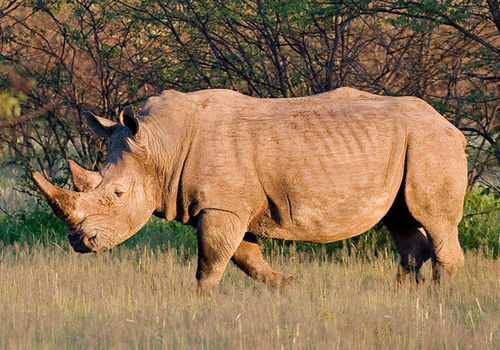
White rhino
Ceratotherium simumWhite rhino
Introduction: After the elephant and hippopotamus, the white rhinoceros (Ceratotherium simum) ranks as Africa's third largest land mammal. They have a barrel-shaped body and short, thick-set limbs. Characteristic features include the long head with continually growing horns, one in front and a shorter one behind.
As both species of rhino are frequently poached for their horns (which are believed to have medicinal purposes, both white and black rhinoceros have become the most endangered large animal in Africa. The horns, which are composed of a mass of tubular filaments similar in substance to hair, are outgrowths of the skin and the front is normally longer than the rear.
White rhinos are not white, the name comes from a corruption of 'wide rhino' – or the rhino with wide lips; a feature that allows it to use the lip to eat short grass. Black rhinos have a more hooked lip, which they use for plucking vegetation off bushes. They are the more aggressive of the two species; black rhino are the ones more likely to charge.
Distribution: White rhino can commonly be seen in the Etosha National Park in Namibia and they have also been re-introduced at the Waterberg Plateau Park.
Diet: White rhino have 4 basic requirements for food and habitat:
Areas with short grass (they are grazers).
The availability of water for drinking and to wallow.
Adequate thick bush cover.
A relatively flat terrain
Colouring: Both black and white rhino are grey, but are inclined to assume the colour of the soil on which they live through mud-wallowing and dusting.
Breeding: Most conceptions take place during the wet season, but the white rhino is not a strict seasonal breeder. Calves are born early in the dry season after a gestation period of 16 months and stay with their mothers for a period of 2 to 3 years.
Size: Around 1.8m at the shoulder and weighing up to 2,300 kg. Females are smaller and lighter at 1,400-1,600kg.
Klein Windhoek

